Chinese cuisine culture is extensive and profound. The eight major cuisines each have their own flavors and characteristics. “It is a delight to have friends coming from afar.” The Chinese people have always been known for their hospitality. When hosting banquets, the hosts always do their best to ensure that guests enjoy delicious dishes. State banquets are even more elaborate. These famous dishes that can appear on the state banquet level can be said to be the “ceiling-level” dishes in the culinary world. Especially these ten dishes. Foreign guests who have tasted them will all be full of praise. Let’s see which ones you have tried?
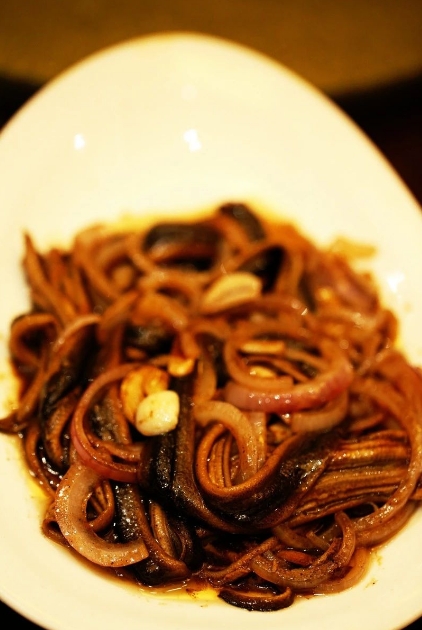
Braised Eels in Soft Pocket
-
Braised Eels in Soft Pocket
Braised Eels in Soft Pocket, also known as “Soft Pocket Eels,” is one of the most famous dishes in Huaiyang cuisine. People in Huai’an like to serve this “fresh, delicious, and unique” dish to guests from home and abroad, making them taste it and praise it endlessly. The first hot dish at the first state banquet in 1949 was this Braised Eels in Soft Pocket, known as the first dish of the founding of the People’s Republic.
As for the origin of its name, there is still no definite explanation. Some chefs believe that “soft pocket” is not, as most people think, that when this dish is served on the table and picked up from the middle with chopsticks, both ends hang down like a child’s belly pocket. Instead, it should be a cooking method. When making this dish, there is a final step of thickening. The taste of all seasonings must be fully adhered to the eel strips, and the tenderness of the eel strips must be maintained, that is, soft. Even if the eel belly that was stir-fried hard at first, it must also soften in the thickening sauce at this time. With the thickening sauce as the base, the eel strips are softly wrapped and held up. This is called “soft pocket.”
This dish uses “Writing Brush Green” eels around the Dragon Boat Festival and is carefully cooked. After being cooked, the back of the eel is shiny black, extremely tender, fresh and refreshing. It is served hot. When picked up with chopsticks, it trembles slightly like it is jumping. It is shiny and smooth. When it enters the mouth, it is tender and melts with a light sip. It leaves a fragrant taste in the mouth.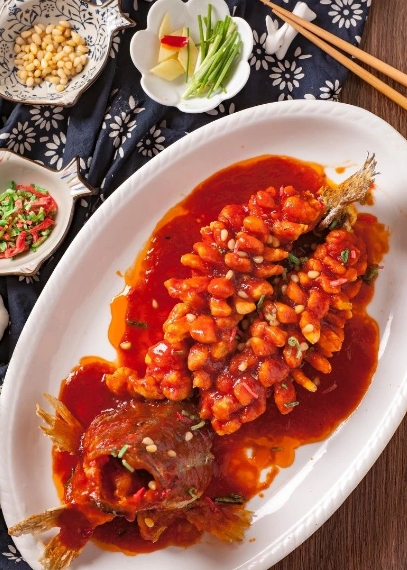
Sweet and Sour Mandarin Fish
-
Sweet and Sour Mandarin Fish
In 1957, Voroshilov, the chairman of the Presidium of the Supreme Soviet of the Soviet Union, visited China and was warmly received with high-level hospitality. Among the state banquet menu that night, there was a dish of Sweet and Sour Mandarin Fish. In addition, this dish was also served at the Hangzhou Summit in 2016. Its appearance frequency is quite high.
Sweet and Sour Mandarin Fish, together with Double-Skin Saury and Steamed Shad, are known as the three delicacies of Jiangnan. Some people vividly describe it as: “Head held high and tail cocked, the color is charming and makes people smile. It looks like a squirrel. When served with thick sauce, it makes a sizzling sound.” Welcome to join the super foodie group of Kitchen Shadows Food (add WeChat zhp20201112 to apply for joining the group). Judging from its appearance, this is a knife-work dish with very high requirements. The chef, with his superb knife skills, cuts the fish along the bone, then slices the fish, making straight and oblique cuts. The knife cuts to the fish skin and turns into a diamond-shaped knife pattern, reaching four-fifths of the depth of the flesh and skin. Every cut is extremely accurate. Eventually, the whole fish body is transformed into 108 garlic clove-shaped pieces, like a chrysanthemum in full bloom. The slightly raised head and tail of the fish echo each other. After frying, the meat pieces turn up like fur. The head is held high and the mouth is open. The tail is slightly cocked. It is extremely beautiful like a squirrel. At state banquets, in order to take into account the feelings of foreign guests, generally the head and tail are removed and only the fish body is served.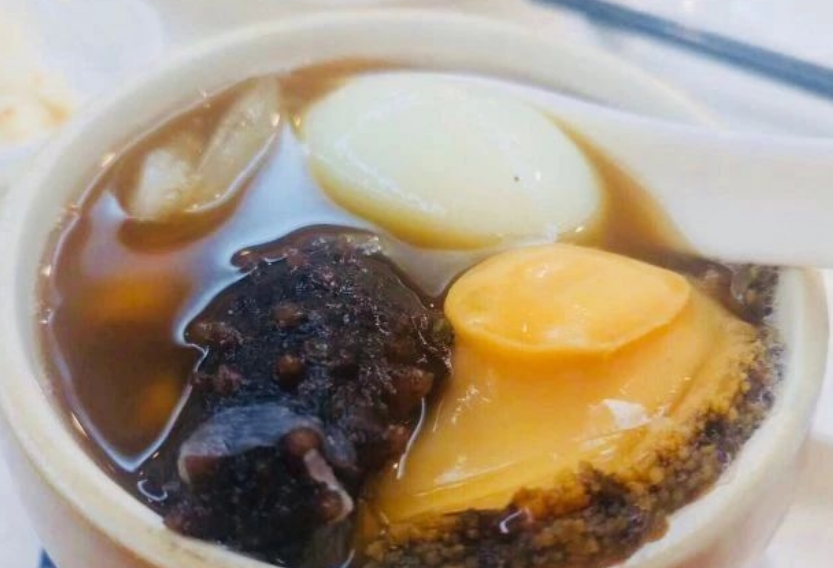
Buddha Jumps Over the Wall
-
Buddha Jumps Over the Wall
Buddha Jumps Over the Wall, also known as “Fullness of Happiness and Longevity.” It is said to have originated in the Tang Dynasty. It is a masterpiece in traditional Chinese cuisine. It gathers the finest delicacies from mountains and seas in one pot and is carefully cooked. When the pot is opened, the fragrance spreads everywhere. The taste is fresh and mellow. There is a poem praising it: “When the pot is opened, the meaty fragrance spreads to the neighbors. Even the Buddha abandons meditation and jumps over the wall because of the fragrance.” It is the first choice of Chinese cuisine with the highest specification for Chinese state banquets. It has been used many times as the main dish at state banquets to receive domestic and foreign distinguished guests. World leaders such as US President Reagan and British Queen Elizabeth and international friends who visited China all highly praised this traditional delicacy after tasting it at the Great Hall of the People in Beijing.
This dish combines eighteen main ingredients and twelve auxiliary ingredients. Its raw materials include chicken, duck, lamb hock, pork tripe, pig’s trotters, tendon, ham, chicken and duck gizzards; there are fish lips, shark fins, sea cucumbers, abalones, scallops, fish maws; there are also pigeon eggs, mushrooms, bamboo shoots, and razor clams. The cooking process is extremely refined: first, the eighteen ingredients are cooked in various ways such as frying, stir-frying, cooking, and deep-frying to make various dishes with their own characteristics. Then, they are stacked layer by layer in a special container and heated on fire. For years, Shaoxing wine jars have always been used as the cooking vessels for Buddha Jumps Over the Wall. There is Shaoxing famous wine in the jar to blend with the ingredients.
Cooking Buddha Jumps Over the Wall emphasizes preserving fragrance and taste. After the ingredients are placed in the jar, the mouth of the jar is first sealed with lotus leaves, and then covered. The fire for cooking Buddha Jumps Over the Wall is strictly pure and smokeless charcoal fire. After being boiled vigorously with strong fire, it is simmered with low fire for five or six hours. When it is cooked and opened, the lotus leaves are slightly lifted, and the fragrance of wine is immediately smelled. This dish has a thick brown soup, but it is thick without being greasy. When eating, the fragrance of wine mixes with various fragrances, spreading everywhere. The dish is tender without being rotten and has an endless aftertaste.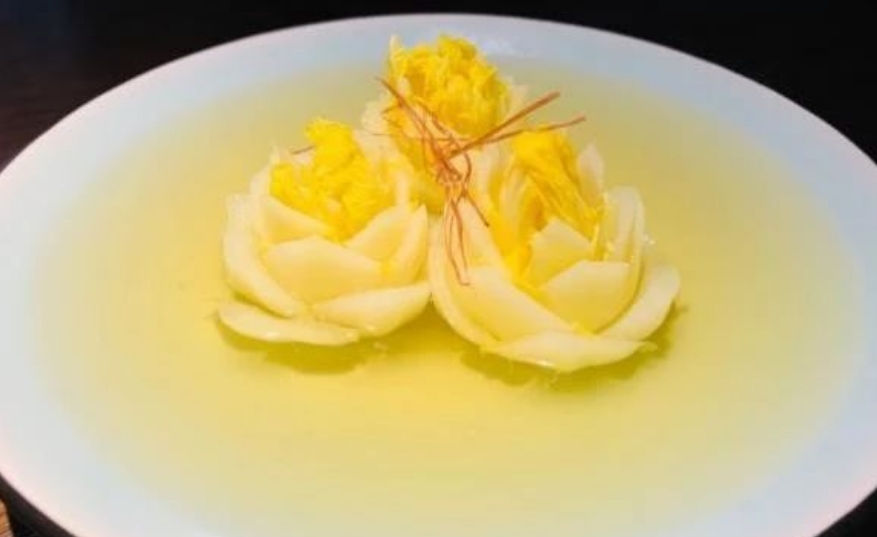
Chinese Cabbage in Clear Soup
-
Chinese Cabbage in Clear Soup
Chinese Cabbage in Clear Soup is a traditional famous dish in Sichuan. It was originally created by Huang Jinglin, a famous Sichuan chef in the imperial kitchen of the Qing Palace. Later, Luo Guorong, a master of Sichuan cuisine, brought its cooking technique out of Sichuan and made it a delicacy on state banquets. This dish has extremely complex craftsmanship and extremely high requirements for raw materials. At least two chefs need to cooperate tacitly. In a very spacious and professional kitchen, with a dozen skilled helpers, a Chinese Cabbage in Clear Soup can be made. This dish does not care about the flamboyance of the main ingredient but lies in the rigor and strictness of making the soup. Seemingly plain and unadorned, it fully shows the refinement of the dish’s taste and the profound skills of culinary art.
According to the rules passed down by Sichuan chefs from generation to generation, “The taste should be rich but not greasy. The taste should be fresh and not bland.” This seemingly plain clear soup is made by putting old hens, ducks, ham, pork ribs, and dried scallops into a soup pot, adding enough clear water, ginger, and scallions, and simmering for at least 4 hours. Then, mince the chicken breast until it becomes a paste, pour in fresh soup and stir it into a slurry, and pour it into the pot to absorb impurities. After absorbing two or three times in succession, the originally slightly cloudy chicken soup in the pot is now as clear as boiling water. The fragrance is strong, mellow, and thick, not greasy and refreshing. As for the cabbage, choose the nearly ripe but not fully ripe Northeast Chinese cabbage as the raw material. Only use the yellowish tender heart in the middle. After blanching slightly, rinse it with cold water. After removing the fishy smell of the cabbage, pour the “boiling water”-like chicken soup on it to scald it until cooked. The clear soup that has scalded the cabbage is discarded. Place the scalded cabbage heart at the bottom of the bowl and gently pour in fresh chicken soup. At first glance, the finished dish seems to have plain soup with no oil or sauce, but it smells fragrant. When eaten, it is fresh, soft, and beautiful, definitely better than all kinds of delicacies.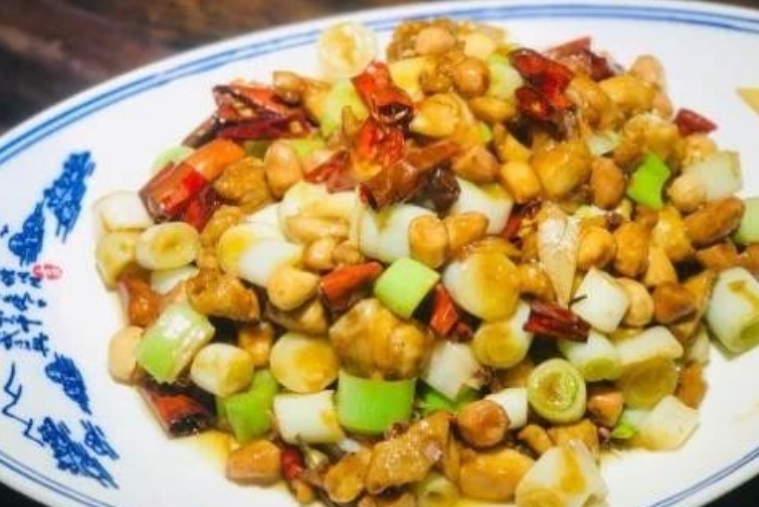
Kung Pao Chicken
-
Kung Pao Chicken
As an ordinary Sichuan dish in the eyes of Chinese people, Kung Pao Chicken was served at the state banquet when US President Trump visited China for the first time on the afternoon of November 8, 2017. It was jokingly called the “cosmic famous dish” by netizens! And Kung Pao Chicken has always been very popular among foreigners.
Legend has it that Kung Pao Chicken originated from Ding Baozhen, a famous official in the late Qing Dynasty. It is made by stir-frying dried chili peppers and peanuts into diced chicken, forming this famous Sichuan dish with a combination of sweet, sour, and spicy flavors. From this, many dishes named after “Kung Pao” have been derived, such as Kung Pao Tofu and Kung Pao Shrimp. This dish is made by blending sugar and vinegar and supplemented with soy sauce for color and cooking wine for flavor. It can be called the “golden ratio.” When you take a bite, first it is sweet and sour, then spicy and hot, and finally salty and fragrant. You can see oil but no sauce. It is extremely distinctive and loved by people.
Wensi Tofu
-
Wensi Tofu
Wensi Tofu can be regarded as the simplest dish to make at state banquets. The reason it can appear on state banquets is that it requires cutting tender tofu into 5,000 “hair-thin” shreds, which is a top test of a chef’s knife skills. The most famous knife-work dish in Huaiyang cuisine is undoubtedly Wensi Tofu, which is almost “superb craftsmanship.” Thousands of tofu shreds as long as toothpicks and as thin as vermicelli float and swim in clear soup, light, white, and exquisite. When eaten, it is both smooth and soft, fresh and delicious. Usually before diners can react, it has comfortably reached their stomachs. While savoring it, people can’t help but praise it.
The making of Wensi Tofu is quite particular. First, peel off the old skin on the surface of the tofu, and then cut it vertically one by one. This is slicing. The slices should be as thin as paper. After cutting, use the knife to gently smear the tofu slices diagonally to make them “lie down” in a stepped shape, and then cut them into shreds. For a soft piece of tofu, usually a large knife is used to cut horizontally at least 88 times and vertically 188 times. In a few minutes, a fragile piece of tofu becomes thousands of tofu shreds. Put it in clear water, and each shred is clear, uniform in thickness, and as thin as hair. It must also be unclumped, unbroken, and not fragmented. This tests knife skills. This skill seems simple, but without three to five years of practice, it is really difficult to handle. During operation, chefs must not only be extremely careful but also bold as a tiger. They must also be calm and unhurried. While watching, one can see the knives rising and falling, and the knife skills are like a swift wind. The whole process is as smooth as flowing water and completed in one go.
Beijing Roast Duck
-
Beijing Roast Duck
Among numerous famous Chinese dishes, Beijing Roast Duck has always remained unshakable and is still a classic national dish for entertaining foreign guests. Beijing Roast Duck originated in the Northern and Southern Dynasties in China. It is recorded in “Records of Delicious Food” that there was roast duck. At that time, it was a court food. It is made of high-quality Beijing ducks, a kind of meat duck. Roasted with fruitwood charcoal, it has a ruddy color, tender meat that is not greasy, and a crispy outside and tender inside. Beijing Roast Duck is divided into two major schools, and the most famous roast duck restaurants in Beijing are also the representatives of these two schools. It is known as “the most delicious food in the world” for its bright red color, tender meat, mellow taste, and being fat but not greasy.
According to legend, the beauty of roast duck lies in the famous Beijing duck. It is currently the highest quality meat duck in the world. It is said that the breeding of this special purebred Beijing duck started about a thousand years ago. It was because the emperors of the Liao, Jin, and Yuan dynasties hunted and occasionally obtained this pure white wild duck species. Later, it was bred for hunting and has continued until now. Only then did this excellent purebred duck be obtained and cultivated into today’s precious meat duck breed. That is, a white duck fattened by force-feeding method, hence the name “force-fed duck.” Not only that, Beijing ducks were introduced to Europe and America a hundred years ago and became astonishingly popular after breeding. Therefore, as a high-quality breed, Beijing ducks have been the source of the world’s famous duck breeds for a long time.
The first way to eat Beijing Roast Duck: It is said that it was started by the ladies in large mansions. They neither eat scallions nor garlic but like to dip the crispy duck skin in fine sugar and eat it. Since then, whenever the waiter at Quanjude sees female guests coming, they will definitely serve a small dish of sugar along with the roast duck.
The second way to eat: Sweet bean paste with scallion strips can be accompanied by cucumber strips and radish strips. Use chopsticks to pick up a little sweet bean paste, spread it on a lotus leaf pancake, put several slices of roast duck on top, and then put a few scallion strips, cucumber strips or radish strips on it. Roll up the lotus leaf pancake. It is extremely delicious.
The third way to eat: Minced garlic with sweet bean paste can also be accompanied by radish strips, etc. Rolling and eating duck meat with lotus leaf pancakes with this seasoning was also a popular way in the early days. Minced garlic can relieve greasiness. Dip the sliced roast duck in minced garlic and sweet bean paste. There is a hint of spiciness in the freshness and fragrance, giving it a more unique flavor. Many customers especially prefer this seasoning.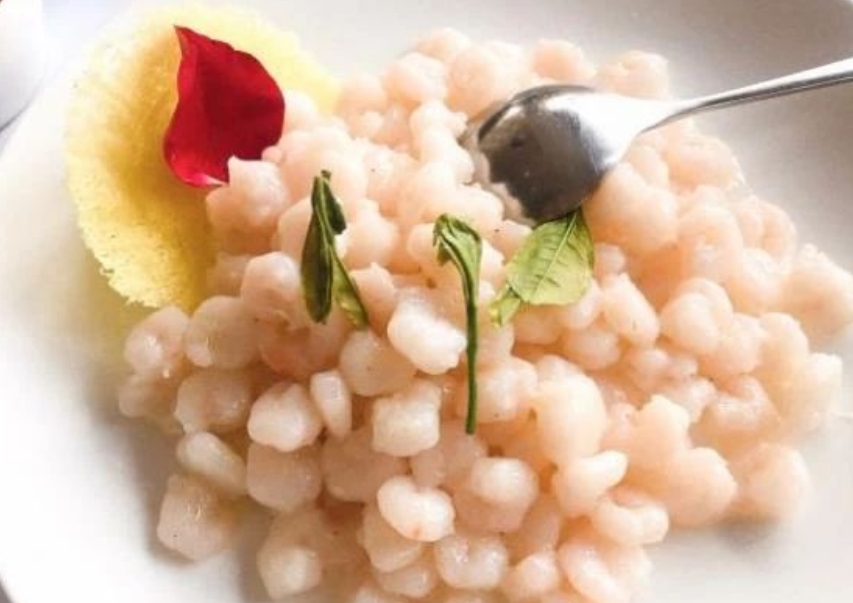
Longjing Shrimp
-
Longjing Shrimp
Longjing Shrimp is named after it is made with Longjing tea around the Tomb Sweeping Festival and shrimp. It is a Hangzhou cuisine with strong local flavors. Longjing Shrimp was listed as a famous Hangzhou dish in 1956. When US President Nixon visited China in 1972, this dish was on the state banquet menu.
According to legend, Longjing Shrimp was inspired by Su Dongpo’s poem “Looking at the South of the Yangtze River” which says, “Let’s try the new tea with fresh fire. Enjoy poetry and wine while we are young.” A Hangzhou chef selected the bright green Longjing tea before the Tomb Sweeping Festival, which is “green in color, fragrant, sweet in taste, and beautiful in shape,” and fresh river shrimp to cook. In “Longjing Shrimp,” the shrimp are jade-white, as beautiful as emeralds and jade, emitting an alluring fragrance. When eaten, they are extremely tender. The Longjing tea leaves are green, fragrant, elegant in color, and unique in taste. After eating, it is refreshing and appetizing, with an endless aftertaste. It is truly a masterpiece among Hangzhou dishes and has become the most famous traditional famous dish in Hangzhou.
Yangzhou Lion’s Head
-
Yangzhou Lion’s Head
One of the famous dishes on state banquets is “Yangzhou Lion’s Head.” It is called “Lion’s Head” because this dish is plump in shape, just like the head of a male lion. This dish is also a typical representative of Huaiyang cuisine. Whether in terms of ingredient selection or production techniques, it fully embodies the delicacy and refinement of Huaiyang cuisine.
Select hard 五花肉 from above the rib. It has distinct red and white colors, multiple layers, a ratio of 30% fat to 70% lean. The combination of lean and fat achieves the effect of tenderness and rich meat flavor. Making Lion’s Head is different from making fish balls or meatballs. Do not mince the pork belly into a paste with a meat grinder. Instead, it is cut out one by one. Welcome to join the super foodie group of Kitchen Shadows Food (add WeChat zhp20201112 to apply for joining the group). First, slice the pork with a flat knife method, and then cut it into extremely small diced pieces with a straight knife method. Roughly cut it into shreds first and then finely cut it into diced pieces, about the size of pomegranate seeds. Do not mince with a knife. Cut it finely! The advantage of this is to maintain the texture of the meat and the tissue remains, maximizing the tenderness of the taste. The key here is not to use a meat grinder or a row knife to mince. A real Lion’s Head is a delicious dish without a single cut.
Not only that, there is also a lot of knowledge in making Lion’s Head cohesive and cooking it. Since the meat is all cut out, it is not as sticky as the meat minced by a meat grinder. In order to achieve a texture that melts in the mouth with a light sip, eggs, starch, and the like cannot be added. To make this pile of uncohesive meat pieces stick together, some real effort is needed. After adding seasonings and high-quality broth, this pile of meat pieces is tossed from left hand to right hand and from right hand to left hand like a ball. Repeat this until it does not fall apart. After putting it into the pot, cook it with gentle low heat for more than 4 hours. The soup surface should always be in a state of seemingly boiling but not quite boiling. Otherwise, if the fire is too high, the Lion’s Head will turn into a soup with minced meat.
The truly impressive skill of Lion’s Head lies in seasoning. High-quality broth must be added to make it cohesive. High-quality broth is made by simmering pig leg bones, old hens, old geese, ham, and other ingredients over low heat for more than 8 hours. It is the source of the umami flavor of Lion’s Head. Bones are the base of the soup, chicken brings freshness, and goose gives a rich fragrance. All three are the soul of high-quality broth, and they have different flavor profiles, naturally giving a layered freshness. A successful Lion’s Head should have both a rich meaty flavor and a refreshing taste. After being served on the table, observe its shape carefully. It has bumps and hollows. That is because the diced fat and lean meat deform to different degrees after being stewed in the soup for a long time. If it is served in a small bowl and shaken carefully and then placed on the table, the Lion’s Head should have a slight tremor in the bowl, just like a lion’s head shaking off water.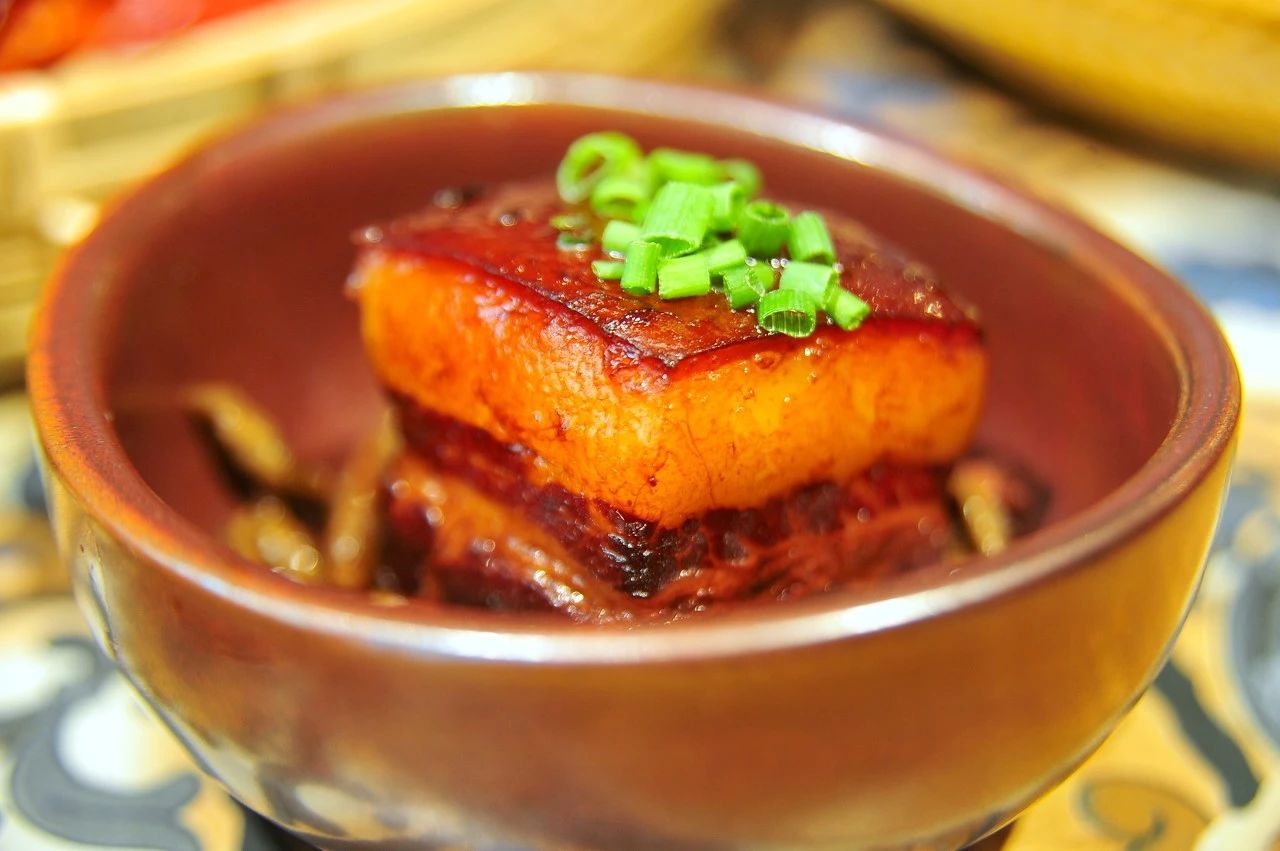
Dongpo Pork
-
Dongpo Pork
As a “hard dish” in Zhejiang cuisine, Dongpo Pork has been selected for the highest-level state banquets many times. In Hangzhou, Dongpo Pork is a famous dish that has been passed down for more than 900 years. According to legend, during the Song and Yuan dynasties, Su Dongpo served as a local official in Hangzhou. At that time, most of the West Lake had been submerged by waterweeds. He mobilized tens of thousands of migrant workers to dredge the West Lake, build embankments, and irrigate the fields for the benefit of the people. Everyone gave him a lot of meat and wine. He cooked them together and distributed them to the migrant workers who participated in dredging the West Lake. Unexpectedly, everyone praised this meat for its crispy fragrance, delicious taste, and being fat but not greasy. So people named this meat “Dongpo Pork” and it has been passed down to this day.
Dongpo Pork is made by braising streaky pork with alternate layers of fat and lean, along with seasonings such as Shaoxing wine and soy sauce. A small, bright red, shiny, and plump piece of meat lies quietly in a small purple clay covered bowl. It has a mellow taste, thick juice, is tender and glutinous, and melts in the mouth. There is a slow flow of wine fragrance between the lips and teeth, and it does not steal the limelight of the streaky pork at all. They complement each other. Even Su Dongpo himself praised this Dongpo Pork in his poem “Song of Stewing Meat”: “Cook slowly with less water. The firewood smothers the flame and there is no smoke. Don’t rush it to cook. When the cooking time is enough, it will be beautiful on its own…”